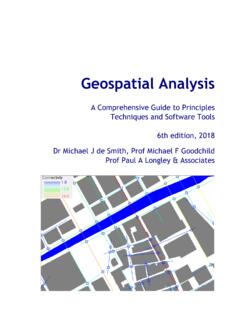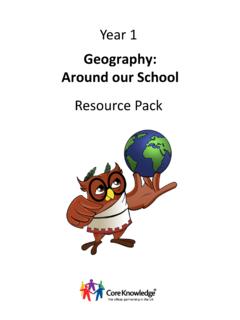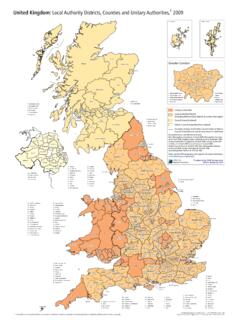Transcription of ORDNANCE SURVEY MAP READING - OS GetOutside
1 ORDNANCE SURVEYMAP READINGFrom the beginner to the advanced map readerContents 3 What is a map? 3 Understanding your map needs 4 Map symbols 5 Map scale 6 The basics 8 Grid references 10 National Grid lines 11 READING contours and relief 13 Know your compass 14 Using your compass 15 Using land features 17 Advanced techniques 17 Pinpointing your location 17 Transit lines 18 Pinpointing your location with a compass 19 Triangulation 20 Aspect of slope 21 Feature interpretation 22 Contouring 23 Measuring the distance travelled on the ground 24 Naismith s rule 24 Walking on a bearing 26 Still can t find your next location? 27 Navigating at night or in bad weather2 What is a map?A map is simply a drawing or picture of a landscape or location. Maps usually show the landscape as it would be seen from above, looking directly down. As well as showing the landscape of an area, maps will often show other features such as roads, rivers, buildings, trees and map can allow you to accurately plan a journey, giving a good idea of landmarks and features you will pass along the route, as well as how far you will be your map needsThere are many different types of maps.
2 The type of map you would choose depends on why you need it. If you were trying to find a certain street or building in your home town you would need a map that showed you all the smaller streets, maybe even footpaths in and around you were trekking across a mountain range you might need a map that shows a bigger area of land and tells you the heights and steepness of the you were a pilot flying from London to Edinburgh you might need a map that has the whole of the country on a single page, with only the locations of towns and cities on it. Whichever type you choose, there are a few basic features usually found on any map, which will be explained in this leaflet. Crown copyright 3 Map symbolsRather than containing descriptions, maps have symbols to show where certain things are. Symbols are used so maps don t have to be covered in writing, as this would make them very confusing. ORDNANCE SURVEY uses different shapes, colours and symbols to show all the roads, buildings, rivers and other features of a landscape.
3 Symbols are designed to be simple, often looking like the features they represent. This means things can be quickly and easily recognised as you look at a map. The symbols here are actually used on ORDNANCE SURVEY maps. Write down what you think they represent:123 Use the blank boxes to draw pictures of how you think the symbols for the following things appear on a map:a. Horse ridingb. Gardenc. Place of worshipd. Lighthousee. Nature trailf. ViewpointHere s where you find out how you answers to the first three questions are a telephone call box, a campsite and a caravan site. To find out how close your drawings are to actual ORDNANCE SURVEY symbols you can look at the key on an ORDNANCE SURVEY map. Maps will usually have a key or a legend. This is a section that will explain what each and every symbol on the map represents. If you find something on the map you don t understand or recognise, the key or legend will help you to identify what it scaleTo create an accurate picture of a landscape on paper everything has to be made much, much smaller.
4 This is done by scaling down the actual size of the land. The map below shows Great Britain. The size of the island has been scaled down so it will fit on this sheet of paper. The map is too small to contain a lot of detail and doesn t have many names on it, as there isn t much : 1:6 000 000 ShetlandIslandsOrkneyIslandsFraserbur hThursoUllapoolBraemarInvernessFort WilliamObanDundeeEdinbur hGlas owNewcastle upon TyneStranraerCampbeltownCarlisleKendalYo rkLeedsIsle of ManDou lasKin ston upon HullLiverpoolHolyheadManchesterBirmin hamAberystwythSke nessNorwichLowesto HarwichCambrid eOxfordFish uardCardi LondonBristolDoverSouthamptonBri htonWeymouthBarnstaplePlymouthPenzanceIs lesofScillyAberdeen5 The basicsThere are some basic features that most maps will include: Roads tend to be marked in different colours depending on the type of road depicted. Roads on a map range from thick blue lines, showing motorways, to dashed lines, indicating an unfenced minor road.
5 Footpaths are marked on ORDNANCE SURVEY maps in various colours. On a 1:25 000 scale OS Explorer map the public rights of way are marked in green and on a 1:50 000 scale OS Landranger map they are marked in magenta. There are various types of public rights of way and public access, so please check the map key for full information. It is important to be aware that footpaths that are shown in black are not necessarily public rights of way. Woods are shown in green with a coniferous or non coniferous tree shape printed over the top. Buildings are marked by small brown squares outlined in black. However, some particular buildings have their own special symbols, such as churches and windmills. Any of these buildings can be useful landmarks, helping you to check your position on the map. Rivers and streams are shown as blue lines. The width of the line is representative of the watercourse width (if the width of a river is more than 8 metres it is shown as two blue lines with a light blue area between).
6 Rivers and streams can be extremely useful in determining your position on a map. Scale tells you how much the land has been scaled down to fit on the paper. If the scale of a map is 1:50 000 then everything on the map will be 50,000 times smaller than it is in reality. Your ORDNANCE SURVEY map will also contain other features and information that will be explained, along with the features above, in the key of the following pages shows a scale comparison between 1:25 000 scale and 1:50 000 scale61:25 000 scale1:50 000 scale Crown copyright Crown copyright 7 Grid referencesOrdnance SURVEY maps are covered in a series of faint blue lines that make up a grid. The lines have numbers accompanying them that allow you to accurately pinpoint your location on a map. Once you have located where you are, the grid system makes it simple to give others (such as Mountain Rescue) an accurate description of your location. This description, which will be a series of numbers, is known as a grid you begin to look at grid references it is important to be aware that all the numbers going across the face of the map, for example, left to right, are called eastings (this is because they are heading eastward), and similarly, all the numbers going up the face of the map from bottom to top are called northings (again because they are heading in a northward direction).
7 Northin s (up the stairs) Eastin s (alon the corridor) There are two main types of grid reference: 4-figure for example, 1945, this identifies a single kilometre square on an OS map. 6-figure for example, 192454, identifies a 100 metre square within a single kilometre square on an OS Grid reference is always for the bottom left hand corner of the grid square you are map referencesWhen giving a 4 figure grid reference you should always give the eastings number first and the northings number second, very much like when giving the READING of a graph in school you must go along the corridor (horizontal) and then up the stairs (vertical).8 Northin s (up the stairs) Eastin s (alon the corridor) For example, the number 2 in the diagram is 19 across and 45 up and therefore the 4 figure grid reference is 1945. The numbered squares on the diagram would have the following 4 figure grid references:1 = 1845 2 = 1945 3 = 1844 4 = 19446-figure map referencesHaving worked out the basic 4 figure grid reference, for example, square 3 above, imagine this square is further divided up into tenths.
8 Using the example right, the blue box is in the square 1844. More accurately it is 7 tenths across and 8 tenths up within the grid square 1844 and therefore has the 6 figure map reference shapes on the diagram would have the following 6 figure grid references: = 1874 4 8 = 185443 Northin s (up the stairs) Eastin s (alon the corridor) 9 National Grid linesAs well as numbered grid lines, OS maps have a two letter prefix. The two letter prefixes can be found printed in faint blue capitals on OS maps. The whole of Great Britain is divided into squares of 100km and each square is given two letters. There will be a diagram within your map s key showing you which areas of your map fall into different squares of the National you quote your grid reference you should put the two letter prefix of the area you are in before the numbers. This means that there is no doubt or confusion about your location. For example, you may be at grid reference 509582 in south west Scotland.
9 The complete grid reference you should quote would be NX 509582 (without the letters the numeric reference would be repeated in every 100km square).HOHPHTHUHWHXHYHZNANBNCNDNENFNGNH NJNKNLNMNNNONPNRNSNTNUNWNXNYNZOVSCSDSETA SHSJSKTFTGSMSNSOSPTLSSSTSUTQTRSVSWSXSYSZ TMSRTV 10 READING contours and reliefUnderstanding the shape of the land by looking at a map is a very useful skill and can be essential if you re going to be walking in mountainous terrain. The height and shape of the land is shown on a map using contour lines . These lines appear as thin orange or brown lines with numbers on them. The number tells you the height above sea level of that contour line is drawn between points of equal height, so any single contour line will be at the same height all the way along its length. The height difference between separate contour lines is normally 10 metres, but it will be 5 metres in flatter areas. The map key will tell you the contour interval used.
10 The picture shown illustrates how a landscape can be converted into contour lines on a map. An easy way to understand and visualise contour lines is to think of them as high tide lines that would be left by the sea. As the water level drops it would leave a line every 10 metres on the landscape. These marks would be contour able to visualise the shape of the landscape by looking at the contour lines of a map is a very useful skill that can be developed with practice. It will allow you to choose the best route for your journey. When READING contour lines on a map it s helpful to remember the numbering on them reads uphill. It might be useful to imagine that to read contour line numbers you have to be stood at the bottom of the hill looking up it, otherwise the numbers would be upside down. Other useful things to look out for when READING contour lines are rivers, which usually flow into valleys, or areas with very few contour lines, which will be picture below shows how contour lines can be used on maps to describe different landscapes.


